
|
Sale 80
June Pre Long Beach Sale
| Lot |
Photo |
Description |
Realized |
Lot 379 |
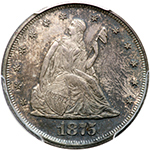 |
1875. PCGS graded Proof 65 PQ. Only 2,790 minted. Nice blue toning on both sides. The Twenty-cent denomination was issued for four years only at the Philadelphia, Carson City and San Francisco Mints. Examples from these deliveries, whether Proof or business-strikes, are typically collected as Type coins. We offer in the present lot a Gem Proof specimen sure to please the condition-census rarity specialist -- this piece ranks among the finer examples of the 2,790-coin Proof issue, with an NGC-certified population given below.
Both sides are naturally toned in shades of charcoal-gray to dusky blue tint while certain areas shine silvery-gray. The designs are very well impressed by the dies; devices lightly frosted with satiny mint luster, and the finish is, as one should expect, reflective. A lovely Gem Proof 65 coin. Pop 19; 13 finer, 12 in 66, 1 in 67 (PCGS # 5303) .
Estimated Value $6,500 - 7,000.
View details and enlarged photos
Check results on similar lots
| Realized
$8,519 |
Lot 380 |
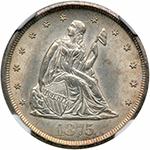 |
1875-CC. NGC graded MS-65. Frosty and well struck for this date. Pop 34; 6 finer, 1 in 65 Star, 4 in 66, 1 in 67 Star .
Estimated Value $10,000 - 11,000.
View details and enlarged photos
| Realized
$12,338 |
Lot 381 |
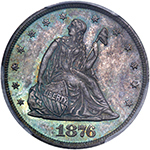 |
1876. PCGS graded Proof 65. Lovely rainbow toning on both sides. Only 1,260 minted. Uniformly toned, the fields show blue iridescence that shines forth with the mirror background provided by the reflective field, while the devices on both sides are sharp-edged and lettering bold throughout. A resolute Gem Proof, in other words, once deserving a place in a high-quality collection of U.S. coins.
The Twenty-Cent piece is one of many curious denominations issued by the United States government during 1800s. It was produced only in 1875 to 1878, one of the shortest series in numismatics. The congressional proposal that resulted in the creation of this denomination originated in 1874. A senator from Nevada, John Percival Jones, introduced a coinage bill for a twenty-cent coin. The year before, the congress had abolished three superfluous denominations, the two-cent coin, the three-cent silver, and the half dime, and these were disappearing from circulation after their abolition through the Mint Act of February 12, 1873. Jones' home state of Nevada was the center of the rich Comstock Lode and of silver and gold, even today, the state is known by the nickname of "The Silver State." He was probably working for these special interests, "bringing home the bacon" as it were to his constituents. Pop 23; 12 finer in 66 (PCGS # 5304) .
Estimated Value $7,000 - 7,500.
View details and enlarged photos
Check results on similar lots
| Realized
$8,519 |
Lot 382 |
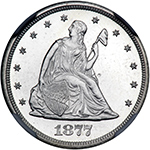 |
1877. NGC graded Proof 66 Cameo. Well struck and fully white. Only 510 minted. Pop 7; 4 finer, 1 in 66 Star, 3 in 67 Star .
Estimated Value $16,000 - 17,000.
Ex: The Kenneco Collection.
View details and enlarged photos
| Realized
$18,800 |
Lot 383 |
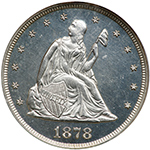 |
1878. NGC graded Proof 65 Cameo. Fully white Gem Proof. Only 600 struck. Although the Western silver producers were selling large amounts of silver to the mints at a decent price in the early 1870s, due to the acquiescence of the Mint Director, Linderman, it never seemed quite enough. Nevada Senator Jones attempted to improve the situation by introducing legislation for a twenty-cent piece, producing the absurd claim that storekeepers in the West were shortchanging customers on the grounds that no five-cent pieces were on hand. There were plenty of half dimes yet in circulation in that area, but no one bothered to mention that fact.
At any rate, Congress did authorize the new coins, but they were the "original" Susan B. Anthony dollars and about as popular as the later model. Authority to coin them was revoked in 1878 and they were quickly forgotten, except by shrewd numismatists.
Stunning original brilliance and mirror "depth" on this one, with simply outstanding surfaces. Even the strike is 100% complete, while we find no distracting handling marks. If you have been searching diligently for a top end Gem of this important Proof-only issue, then here is a high-end example for the brilliant-coin lover. Philadelphia coined Proofs only in 1878; the denomination was put out to pasture, as it were, after 4 short years of very limited production. Worth a premium for the majestic beauty and cameo effect, and certain to please the advanced collector. Pop 16; 7 finer, 5 in 66, 2 in 67.
Estimated Value $8,000 - 8,500.
View details and enlarged photos
| Unsold |
Lot 384 |
 |
1878. PCGS graded Proof 65. Proof only year. Nice blue and lilac toning. Only 600 minted. Here's a lovely coin, both sides fully Gem in quality with smooth, virtually unhairlined surfaces. Though not carrying the Cameo designation, we do notice some light frostiness on the raised portions. A coin whose PCGS Proof 65 grade is also justified, the surfaces with strong contrast between mirror field and razor-edged devices. Naturally toned, we can easily see this coin fitting into a top-quality collection.
The 1878 is the final date in the brief, Twenty-Cent series which ran from just 1875 to 1878. It is also one of two Proof-only deliveries of the Type, the mintage amounting to just 600 pieces, as we've already mentioned. While not as rare as the Proof-only 1877 in an absolute sense, the 1878 is pretty much as difficult to find in the highest grades. Pop 27; 12 finer, 11 in 66, 1 in 67 (PCGS # 5306) .
Struck at the zenith of America's "Gilded Age," this twenty-cent piece appeared during an era of industrial growth and labor unrest. Because most Americans spent long hours at their jobs in the late nineteenth century, upwards of 10 to 12 hours a day, six days a week, few had the freedom or the wherewithal to devote to coin collecting. Hence, the small Proof coinage figures of the 1870s. Today, a hundred twenty-six years later (a mere clock tick in the span of human history), we have adequate leisure time to enjoy reliving the past; and coins like the Gem offered here provide a string through time binding that earlier Gilded Age to our own "Age of Discontinuity" as the social commentator, Peter Drucker, termed it.
Estimated Value $7,500 - 8,000.
View details and enlarged photos
Check results on similar lots
| Realized
$8,813 |
Lot 385 |
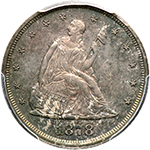 |
1878. PCGS graded Proof 65 PQ. Only 600 minted. Lovely toning on both sides. Unfathomable depth of reflectivity is seen in the fields under the color with fine, but noticeable frost over the devices. The centers on each side are really quite well impressed from the Proof dies, with the devices being struck carefully and with determined force by the dies so that all design elements show boldly. Although the Western silver producers were selling large amounts of silver to the mints at a decent price in the early 1870s, due to the acquiescence of the Mint Director, Linderman, it never seemed quite enough. Nevada Senator Jones attempted to improve the situation by introducing legislation for a twenty-cent piece, producing the absurd claim that storekeepers in the West were shortchanging customers on the grounds that no five-cent pieces were on hand. There were plenty of half dimes yet in circulation in that area, but no one bothered to mention that fact. At any rate, Congress did authorize the new coins, but they failed as a superfluous denomination when two dimes would suffice. Pop 27; 12 finer, 11 in 66, 1 in 67 (PCGS # 5306) .
Estimated Value $7,500 - 8,000.
View details and enlarged photos
Check results on similar lots
| Realized
$8,225 |
|
|